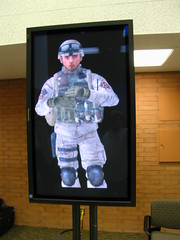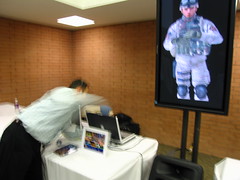I arrived a couple of hours late for a day-long series of presentations on what the ICT is doing these days.
Flatworld is an environment for training and simulation that uses stage “flats” as projection and display surfaces.

Their stated motivation is to create an environment motivated by the science-fictional Holodeck from Star Trek: TNG. In addition they use 4D sensory effects — blowing wind, vibrating floors, to add an additional degree of sensory effect.
These digital flats are very much like those used in theatrical contexts — they’re plywood structures with rear-projection screens and the like — and they can project human-scale characters and environments. So, the idea is that you might be a soldier who’s training for room incursions or sniping and you’d actually be moving around a “set” with projections and other sensor effects to enhance the sense of immersion.
All of the videos for the project show the distinctive military character of the research, which isn’t surprising. It’s a mixed reality world that includes props and such all in the built environments.

Sgt Blackwell is having trouble hearing. Some loose cables?
I met Sgt. Blackwell, a character that’s being used in these Flatworld environments. Here’s a video of him introducing himself (“..whu-uh”) and one of him explaining the relationship between himself, the military and the entertainment enterprise.
—————————————–
Future Directions
* New Mixed Reality Displays — paint the real world with digital light (like Naimark’s project?) so that any surface can be rendered upon.
* Localized audio (Holosonic) projection “Audio Spotlight”
External Collaboration
*Newseum, Washington, came to them to develop two highly interactive exhibits to put people onsite as if they were photojournalists.
From Training to Toy to Treatment: Design and Develoopment of a PTSD (Post Traumatic Stress Disorder) VR Exposure Therapy Application for Iraq War Military PersonnelHow to use VR to decompress Iraq War veterans? Clinical aplication to treat post-traumatic stress disorder.
Photo of Sigmund Freud with an early VR headmount.
There were a bunch of projects working on tragic scenarios supposedly for rehabilitation and such. These included a bus bombing, the World Trade Center, Vietnam. I was surprised there were so many.
ELECT Project: Educational game for Bi-lateral Background
- support the ‘strategic corporal’
- accelerate the development of agile leaders
- enhance cultural awareness
- rapidly transfer lessons learned from Contemporary Operating Environment (code name for what’s going on in Iraq and Afghanistan and other places.)
Motivation
Leadership in the US Army is a key component of success but over the last 15 years (cold war to situations all over the world) high level decision makers are migrating downwards toward the Corporal from the General/Statesman.
Learning Objectives
- conduct a bi-lateral engagement
- prepare for and conduct a bi-lateral meeting
- analyze the results of the meeting
- use negotiation techniques
[You’re in meetings with locals, how to prepare, conduct, analyze, employ good negotiation strategies in a cultural context, where you are somewhat savvy about the way the local cultural context works so you can conduct yourself appropriately.]
Approach
- Game-like social simulation [SimCity, Sims]
- social simulator – macro & micro
- Interactions with virtual humans
- automated director – right experiences
- Intelligent tutor – learning from feedback
- After Action Review – learning through reflection
* Play-centric design
** Focus is on the player experience
** Everyone on the team participates in the design process, but the designer must be the ‘advocate for the player.’
** In the best case scenario, production is the thoughtful implementation of design
A new approach to Game AIImmersive approach to AI (as opposed to Functional or Cognitive) entities that appear smart or intelligent that support a sense of immersion in the game world
references
Postcard From SGS 2005: Inside The Institute for Creative Technologies
Why do I blog this? It seems that the military industrial light and magic complex theme is riding high in my life as of late. This is another of those meme swells. I have to say that the work isn’t all that fascinating creatively, but that’s to be expected I suppose. It is more of an attempt to integrate the entertainment world’s genetic code into military simulation projects. Actually, that sounds way too one-way. It’s a shared knowledge tangle. A “collective” of knowledge sharing, formally (e.g. money, talent, consultantancy back-and-forth) and informally (e.g. off-handed associations with a game someone’s kid plays). It’s one of [w:Bruno Latour]’s “Things”, for certain, and a collective as a complex knot of messy entanglements and hybrid associations. (cf From Realpolitik to Dingpolitik — How To Make Things Public
Elements from the entertainment world that were mentioned here:
- Saving Private Ryan (audio immersion was overheard during one of the breaks as a profound element that was so strong that it caused that individual to have trouble sleeping after seeing the movie)
- [w:Age of Empires]
- [w:Electronic Arts]’ game AI competition
- [w:Halo]
- [w:SimCity]
- “[w:Steven Spielberg]”
- [w:Deep Blue] (IBM’s champion chess playing computer); The Truman Show
- “the world of animation” (use of key framing applied to designed experiences so that a designer provides a few plot points and an AI negotiates a seamless path through those plot points)
- “Wizard of Oz”, as a display metaphor — hiding behind the curtain to control a simulation
Technorati Tags: augmented reality, military, military industrial light and magic complex, mixed reality, simulation